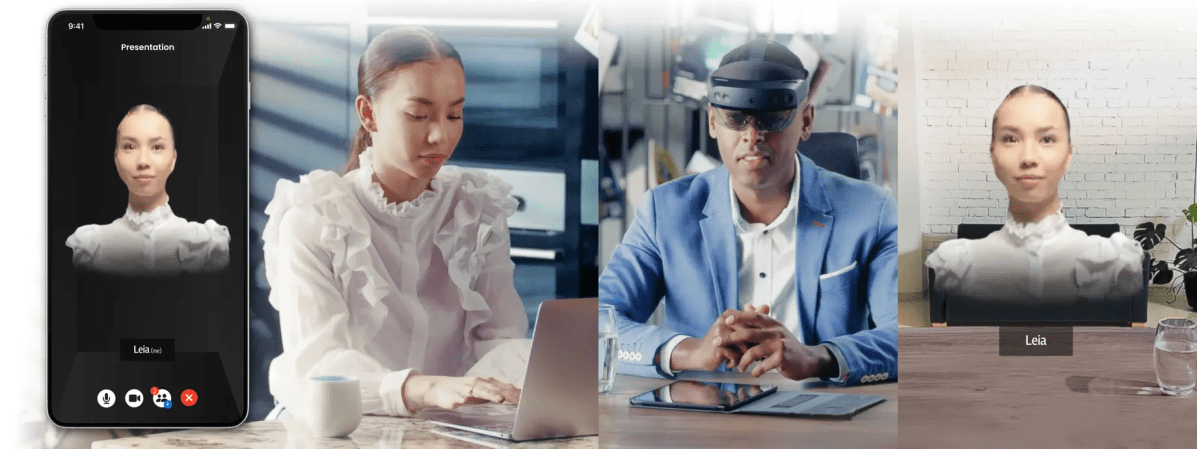Leading European telecom operators Deutsche Telekom, Orange, Telefónica and Vodafone, together with the deep tech company MATSUKO, have conducted a pilot to make holographic calls as easy and simple as making a straightforward phone call by interconnecting their deployments so that their customers can join a common holographic communication session. The companies are also developing a platform that will combine the real and virtual worlds through a mobile connection, using a smartphone camera to generate a 2D video which is then rendered into 3D holograms in the Cloud to be streamed to viewers in an AR/VR/MR environment with a clarity and sharpness never previously possible.
The trial platform uses the attributes of 5G connectivity (high speed, high bandwidth and low latency) to overcome some of the challenges in creating realistic 3D imagery which existed until now. Holograms are created using the selfie camera of a smartphone to capture and transmit a real-time three-dimensional holographic image of a person before processing through an advanced 3D rendering engine. It then delivers a ‘virtually there’ immersive experience and displays it in a virtual environment or overlays it onto a real-world setting, using virtual reality / augmented reality glasses.
Having successfully completed the first phase of the collaboration, the parties will continue improving the underlying technology, with a focus on quality of service. The parties are currently examining the potential for broadcast-like delivery, creating the possibility of entire events or presentations to be conducted virtually with stunning realism. Future applications could include person-to-person or ‘few-to-few’, enhancing communication in both consumer and business settings. Key to this realism is the use of mobile edge computing technology – so-called ‘distributed networks’ whereby network and application intelligence is operational further away from the network core – vastly improving both latency and bandwidth, which are essential to ensure the most vivid and reliable VR and mixed reality experience.
The results have been encouraging, thanks to 5G and cutting-edge technology. Previous network-related issues that impeded the smooth and natural holographic movement of the holograms have been resolved. Furthermore, MATSUKO’s platform ensures that the end result benefits from better colour and texture resolutions, increasing realism when viewed on a smartphone or other mobile device and without the need for a video headset will enhance the immersive experience.
Alex Froment-Curtil, Chief Commercial Officer of Vodafone, said: “The metaverse brings a new dimension to the future of connectivity, with exciting new experiences for communicating with friends and family, or even for businesses to connect with their stakeholders.This proof of concept moves holographic communications dramatically on from science fiction to real life smartphones”.
Daniel Hernández, VP Devices & Consumer IoT of Telefónica, commented: ” We are confident that in the near future, we will be able to offer our customers a new way of communicating, using this new holographic technology to deliver a more immersive “virtually there” experience. Our cross-operator collaboration with MATSUKO will help to accelerate this innovation and ensure that it works no matter which operator you choose”.
Karine Dussert-Sarthe, Executive Vice President, Marketing and Design, Orange Innovation, said: “Thanks to this unique multi-operator collaboration, we are preparing our infrastructure to deliver open, interoperable and easy-to-use holographic communication services. A first but meaningful step towards the metaverse, a world in which Orange will support its customers with new experiences and interaction possibilities”.
Sven von Aschwege, XR Topic Lead Global Devices Partnerships at Deutsche Telekom, said: “We are in an exciting phase where new technologies are emerging and with them new possibilities. Making phone calls as if the person I’m talking to is standing in front of me is one such dream that is now moving closer to reality. We are testing these holographic calls together with other mobile communications companies. After all, they only really make sense if they work with everyone and not just with a company’s customers”.
Speaking about the trial, Matus Kirchmayer, MATSUKO’s CEO said: “The objective of initial pilot was to deliver a ‘one-to-many’ holographic experience with a virtualised broadcast approach that would enable an audience to see an individual present virtually – as a hologram – with stunning realism”.
